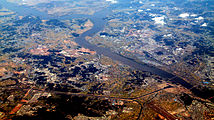Han River (Korea)
![]()
This article is about the Han River in South Korea. For the Han River, which flows into the Yangtze River at Wuhan, see Han Jiang.
The Hangang (= Han River) is with 497.5 km the fourth longest river on the Korean Peninsula and the second longest in South Korea.
The northern branch (Bukhangang), which is 325.5 km long, rises in North Korea near the Kŭmgangsan, and the southern (Namhangang) (394.25 km long) in the Geumdaesan Mountains in Gangwon Province, South Korea. After joining at Yangsuri (35 km from Seoul), the Hangang flows in a W-shape through the South Korean capital, then northwest, where it forms the border with North Korea, and empties into the Yellow Sea off Ganghwado Island.
An ancient inscription from the time of King Gwanggaeto (reigned 391-413) names the river Arisu (아리수; 阿利水).
· 
Slope between Gimpo and Goyang west of Seoul
· 
hillside near Seoul
Questions and Answers
Q: What is the Han River?
A: The Han River is a major river in South Korea and the fourth longest river in the Korean Peninsula.
Q: Where does the Han River flow into?
A: The Han River merges with the Imjin River and flows into the Yellow Sea.
Q: How long is the Han River?
A: The total length of the Han River is about 514km.
Q: What is the history of the Han River?
A: The Han River played an important role in Korean History.
Q: Why is the Han River no longer used for navigation?
A: The Han River is no longer actively used for navigation because it is located at the borders of the two Koreas.
Q: What are the rivers that join to form the Han River?
A: The Han River originates from two rivers, the Namhan River and the Bukhan River.
Q: What is the width of the Han River at its broadest point?
A: The Han River is over one kilometer wide at its broadest point.
Search within the encyclopedia